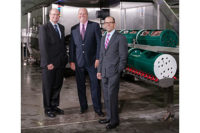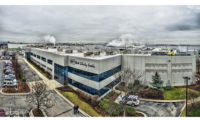
Tough economic times can cause some companies put the business of standing out and succeeding at a lower standard than they would during better days. West Liberty Foods LLC, on the other hand, has been a shining star in the meat business, expanding its facilities and growing its business through the most recent difficult times. Whether winning awards for food safety, or doubling the size of its newest plant in Tremonton, Utah (open less than two years), West Liberty has demonstrated the ability to weather a weakened economy and stay on target building its business.
Based on this success, West Liberty Foods has been named recipient of The National Provisioner’s 2009 Processor of the Year award.
Beyond being a successful company, however, West Liberty has proven time and again to be a processor that understands the importance of sharing the details of its food-safety and quality accomplishments with the rest of the industry. To West Liberty Foods, that knowledge should be shared to raise the overall level of quality, rather than just the quality of one, explains Ed Garrett, CEO of West Liberty Foods.
“There is great knowledge and there are great programs out there by all food manufacturers, and if we’re willing to share the successes AND failures — because some things can bite you every now and then, and you have to share those so that somebody else doesn’t have the same issue — we can help the industry quite a bit,” he says. Food safety, in particular, is one area in which West Liberty Foods is more than willing to assist other processors, with its October 2008 food-safety event held in conjunction with Iowa State standing as a testament to West Liberty’s commitment to furthering the cause.
Built like a rock
It takes a strong, well-organized company to stay the course during tough economic times, and an even stronger will knitted into the fabric of that company’s culture to succeed to the point that expansion is necessary while some companies curtail production and idle facilities. West Liberty Foods, Garrett says, couldn’t have built the Tremonton plant or expanded it without the culture modification that took place a few years ago.
“The culture has changed, and [associates] know that West Liberty Foods is going to produce the safest product possible and meet or exceed the customers’ expectations each and every time,” he explains. “So for our core business, it’s not very difficult to stay the course anymore, because it’s really embedded in our organization from hourly associates all the way up to our board and owners.”
Garrett adds that, even under good circumstances, it can be challenging to add value to a company’s product line or keep associates focused on the long-haul goals of the company, but tough decisions need to be made during both easy and tough times.
“There’s no doubt the economy has affected the industry in total, but you have to be ahead of it,” Garrett says. “You can’t sit back and let the economy dictate to you what you’re going to do, you have to dictate to it. You have to be able to take a risk, knowing with the best of your ability that you think that’s the right direction.
“If you make a good product, involve your entire organization from top to bottom and stay in tune to what your customers’ needs are, you’re going to make the right decision most of the time. Then you’ll be able to get your way through times like these.”
Getting stronger
Nothing has changed in terms of West Liberty Foods’ mindset on these types of issues either, with Garrett hinting that further growth is on the horizon for the company, through a wide variety of avenues. Looking at consumer trends, for instance, West Liberty Foods has determined it needs to be more involved on the retail side of the equation.
“We do see that with the country where it is, the families are coming back to the home lunch and dinner table, and we need to be part of that,” Garrett says. “So we are looking at the retail arena much more strongly than we have in the past.”
Garrett advises that West Liberty Foods will be introducing new products and retail products “very rapidly.” Of course, Garrett adds, any venture into retail doesn’t mean West Liberty Foods will be neglecting or slowing innovation in its wheelhouse capability — slicing.
“We also designed Tremonton to add another 10 slice lines and continue our growth in slicing, and I think we’ll continue to travel down that path with the proven record we’ve had in slicing,” he explains. “Do I see us breaking ground and adding new slice lines in the next six to 10 months? No. Would it surprise me if we’re not seriously laying out the details and drawings within the next 12 months? No.”
Garrett believes that West Liberty Foods could witness the hatchings of another expansion in the very near future, based on the track record at Tremonton (expanding well ahead of the original schedule) as well as the fact that Tremonton’s capacity is filling up quickly. Further growth for West Liberty Foods also may occur geographically, according to Garrett.
“Everyone has to take miles off the food, and we’re very well located to service the Midwest and we have a location in the West, but we put a lot of miles on the food going South,” he says. “As our business grows and as we get stronger, if you look at our past history, it would say that we’re moving product too far south, putting too many miles on it, and we should take a look at what makes sense for us in the southern states.”
Garrett explains that plan would have been a little stronger before the economy faltered, and the company is in a bit of a wait-and-see mode on how the economy responds before West Liberty Foods moves forward with this strategy.
It’s one of the few times in the past year or two that West Liberty Foods has appeared to take on this wait-and-see attitude — but from all indications, it has been a strategy that works. West Liberty Foods does not fear change, and Garrett says that in the next few years, his company will be a different company, guaranteed, than it is today.
“Our core beliefs and business will be the same, but we’ll be a totally different company in four to five years,” Garrett says. “Four years is a long time. Consumers’ habits and needs change routinely, and if you don’t change with them, you get stagnant and left behind. We won’t let that happen.”
Tremonton production
Aside from the success it communicates, there is an additional benefit to expanding a facility within one to two years of its initial construction. With the proper plan in place, there won’t be much difference, cosmetically, between original portions of the plant and new portions. Such is the case at the Tremonton facility, which even prior to the recently completed expansion, was a groundbreaking slicing plant in its own right.
To service its customers best, West Liberty Foods decided that it needed customized equipment that could handle 10-foot-long logs of product from stuffing right up to slicing. In the frying room, six of these logs pass through a fryer simultaneously, and then through a nitrogen cruster — a process that sounds simple enough until one considers the space constraints. West Liberty Foods called on its conveyor suppliers to design a custom transfer system that extracts the logs from the fryer lengthwise, then shifts them horizontally across the room to the cruster and transports them into the equipment, returning the logs toward the wall through which they entered the room. (See photo on page 18.)
Once the logs leave this room, they travel across another similar side-transfer conveyor system and can be sent to one of two slicing rooms. Tremonton’s slicing rooms (all 10 of them) are nearly carbon copies of one another, with the only differences being the specific slicing, weighing and packing equipment found in each.
Product enters through the smallest possible opening in one wall, is processed and packaged, and then sent out through the smallest possible opening in the opposite wall to be boxed up and sent to shipping.
Each slicing room acts as its own island of food safety. Hands must be washed upon entering each room and gloves worn. Everyone in this area of the Tremonton plant wears full body suits, complete with hoods, goggles and facemasks. West Liberty Foods takes the safety of its product to the pinnacle of importance, and thus takes zero chances.
During The National Provisioner’s visit, West Liberty Foods was pumping out a wide variety of sliced meats, including turkey ham/turkey salami/turkey bologna setups for Subway, a sliced, whole-muscle roast beef product (which uses the latest in whole-muscle slicing technology, according to West Liberty Foods), and semi-dry Genoa salami and pepperoni slices, among other products.
Beyond the slicing rooms, West Liberty Foods also needed customized equipment to handle the giant, 10-foot logs, including special racks, pallet jacks and smokehouses, among other things. Even the slicing equipment was tailored to handle these 10-foot-long logs specifically. West Liberty Foods challenged its suppliers to come up with solutions to meet its own needs when designing the Tremonton plant, and the company was pleased with the results.
These partnerships paid off again, as they were extended to the facility expansion, through which West Liberty was able to double its capabilities to meet its growing demand.
But Tremonton isn’t all about sliced lunchmeats — Tremonton represents the entrepreneurial attitude of the company perfectly, through its IQF (individually quick-frozen) poultry lines. The plant originally featured one IQF line, but added a second during the recent expansion, and these lines together produce 25 million to 30 million pounds of poultry strips and patties annually.
Frozen poultry breast meat arrives on the raw side and is placed into one of six tumblers to steam-defrost prior to processing. According to Dave Frett, plant manager, Tremonton defrosts about 100,000 pounds of poultry per day. The poultry is cooked, cut up (if required) and grill-marked before heading into the blast freezer, which divides the raw and ready-to-eat side of this processing line. Once frozen, the product is checkweighed, bagged, boxed and sent to shipping.






